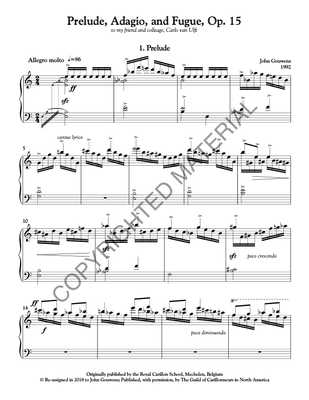
[PDF] Prelude, Adagio, and Fugue
Program notes
This composition was awarded the "Jef Denyn Prize" (First Prize) in a carillon composition competition sponsored by the Royal Carillon School in Mechelen, Belgium. As a consequence of this win, performance of it was required of all contestants of the 1993 Queen Fabiola International Carillon Playing Competition. Since it was written to be a contest piece, it does indeed demand a great deal from the player, musically and technically, and stretches the capabilities of the instrument as well. It was originally published by the Mechelen Carillon School; when it was discontinued in Belgium, the GCNA took up its publication. The Prelude, Adagio, and Fugue contrasts sections written in the octatonic scale (alternating half-steps and whole-steps—very effective on the carillon) with more conventional uses of the major scale.
The work is primarily built on two motifs, both of which appear at the beginning of the piece; both are presented as accented notes sounding from within a rapid 16th-note figuration. The first is a short, lyric theme. The second is a closely-spaced figuration (f-g-d-e-f) which later grows in importance. These two elements, along with the urgent, repeated-note figuration that opens the work, are developed and combined in various ways in the Prelude. All are cast in the octatonic scale. This leads, without break, into the Adagio, which is an extended treatment of the first motif, now in a major tonality. An accompanimental figuration toward the end of this section reintroduces the second motif, which shortly thereafter becomes the subject of the Fugue, again in octatonic tonality. In a fugue, the theme (called the subject) is presented by itself at first, then that voice becomes the accompaniment as the subject enters in another voice. These two voices then accompany as the third voice enters with the subject. In this fugue, an assortment of figures accompany the subject, eventually including slowed-down quotations of the other (lyric) theme from the work. The fugue climaxes with a bold extension of the subject in three octaves at once. (Actually, in a preliminary version of this piece, I wanted to play that figure in four octaves at once, but that proved to be completely impossible to play!) This is immediately followed by a coda (a sort of musical appendix), which presents a new, soaring melody over wide-ranging arpeggios, all in the octatonic scale. This leads directly to a re-statement of the fugue subject, now transformed into a major tonality. The work concludes with a brief re-appearance of the opening of the Prelude.
—John Gouwens
![[PDF] Prelude, Adagio, and Fugue [PDF] Prelude, Adagio, and Fugue](https://d2j6dbq0eux0bg.cloudfront.net/images/9481258/4455092812.png)
